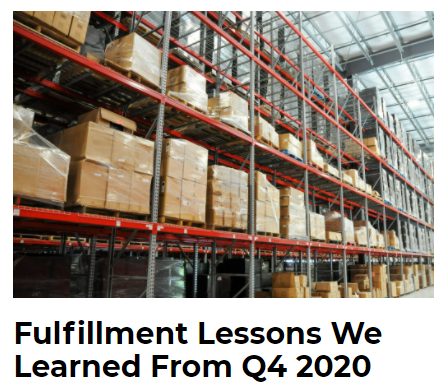Every year, retailers pace nervously like racehorses at the starting gate as they wait for the holiday gift-buying season to begin “officially” on the day after Thanksgiving. Black Friday earned its name because it is the day of the year when retail businesses supposedly move from the red (net loss) into the black (making a profit). For eCommerce sellers and brick and mortar retailers, the last weeks of the year can be a make-or-break period. Many look to Black Friday for signs of what kind of shopping season to expect. As sales and foot traffic on the day after Thanksgiving trend down, and the pandemic has reshaped normal commerce, we must ask the question: does Black Friday matter anymore?
Let’s look at three arguments around Black Friday’s future.
We originally wrote this blog in November 2016, but a lot has changed since then! So, we updated this post on Oct. 29th, 2021 with new data, sales capabilities, and eCommerce and 3PL information based on the realities of the pandemic and ongoing supply chain pressures since then.
1. Black Friday is doing just fine

To paraphrase Mark Twain, the reports of Black Friday’s death are greatly exaggerated. The National Retail Foundation’s (NRF) annual Black Friday survey continues to show the number of shoppers on the Friday after Thanksgiving declining and the amount spent per shopper also going down over the past few years. But let’s give those numbers some context and offer a focus on your online sales.
For starters, millions of people start shopping before they have fully digested their turkey on Thanksgiving Day. There is a little backlash against this trend because it takes store employees away from their families (or their football games) on what many consider an essential holiday. But, retailers have found other ways to make up for this. Many start “Black Friday” sales several days before the mad scramble on the actual day.
The NRF previously tracked foot traffic for Black Friday, but now there’s a substantial mix of online and in-store shopping that the company tends to look at both. That expansion shows how much the market has truly changed. Retailers have moved from 74 million Black Friday shoppers in 2015 to just under 200 million people shopping across the weekend after Thanksgiving. That said, Black Friday still drives a substantial amount of spending, shopping, and marketing. When most people think of the holiday sales season, they think of Black Friday, even if buying online.
To add local color to the festivities, many independent merchants hold special events to cash in on Black Friday sales that otherwise flow mostly to big national retail chains. Events such as Plaid Friday and Small Business Saturday are replicated around the country, encouraging people to shop locally and try many different retailers.
On a day when most people are off work, Americans want to go shopping.
2. Black Friday is on a slow decline
Black Friday is on its way out. Every year, online shopping takes a bigger bite out of brick-and-mortar retail. Cyber Monday is creeping closer to Black Friday, with deals starting on Sunday or earlier. In fact, many of the people who storm the doors at malls across the country the day after Thanksgiving aren’t there to buy. They have come to look. Once they decide what they want, they will go online and look for better deals.

As smartphones and tablets increase the reach of eCommerce and the availability of fast Wi-Fi spreads, eCommerce becomes a far more powerful retail force. Customers who don’t want to brave the crowds of crazed shoppers in manic pursuit of Black Friday deals can shop till they drop from the comfort of their sofas.
There is also a rising tide against Black Friday. A recent trend of opening ever earlier, including on Thanksgiving Day, seems to be reversing, with more stores no longer open on Thursday. While some big retailers will still open their doors at 12:01 on Friday morning, others aren’t. You’ll often see many ads for companies promoting employee health and time off during this holiday season. What’s important to realize is that this is still marketing — their online stores are open and ready for business.
Add to this the fact that up to half of people who shop the weekend after Thanksgiving will look for online deals, and Black Friday starts to look decidedly pale. Online shoppers spend more per person and eCommerce holiday sales continue to experience double-digit growth. With stores that never close, eCommerce sellers make the concept of Black Friday practically obsolete.
Can you trust its promises?
The forecasts of holiday sales trends that come out of Black Friday aren’t to be trusted either, according to data site 538.com. So even the news reports about Black Friday sales are primarily hot air. Even the NRF has changed its tune, noting that Black Friday deals and promotions may be mainly marketing designed to get people to shop online — especially on Cyber Monday.
In 2020, more than 90% of respondents in an NRF survey said they’d be looking at sales and promotions throughout the entire year for their holiday shopping. So, we’re seeing strong growth in spending habits spread out across the year. What’s left to see is if consumers have been budgeting and turned those plans into reality, or if it was mostly wishful thinking.
Today, Black Friday deals that lure shoppers are coming early too. Amazon, Walmart, and Target are among the large retailers offering special holiday sales prices starting in November, both online and (for Target and Walmart) in-store. We’re among the companies recommending this practice to help you fill the orders your customers have.
3. Black Friday is just so 2007

Black Friday has always been more about chaos than cash register cha-ching. In 2005, Black Friday became the biggest shopping day of the year, but it wasn’t on top before that, and it had slipped back to second place by 2014, behind the Saturday before Christmas, sometimes called Super Saturday. Cyber Monday 2020 statistics show that it took over from Black Friday as the biggest shopping day of the year, bringing in about $2.4 billion more. Surveys also note that more people say they’ll shop on Cyber Monday this year.
Black Friday shoppers are more likely to be looking than buying. By the weekend before Christmas, customers are done being choosey – they are ready to open their wallets. If you put together the days leading up to Christmas, you have most of the top retail sales days of the year lined up in a neat little row.
The big push in online commerce tends to come earlier in the holiday season to allow for shipping time, but there’s no time for bricks and mortar retailers like the last minute. For online sales, there’s no telling when the big bump will happen this year. Plan ahead, promote now, and see what business you can win with plenty of time to protect against supply chain disruptions.
We’re a nation of procrastinators. Your Aunt Margaret, who has all her Christmas shopping done in July, is not the typical shopper. But with the 2020 and 2021 supply chain issues, her habits are becoming a lot more common. Black Friday is a valiant attempt to get us to think ahead and get a jump start on our Christmas shopping. The big eCommerce question is if that’ll work and help your customers be part of a solution in protecting you from supply chain and fulfillment concerns.






